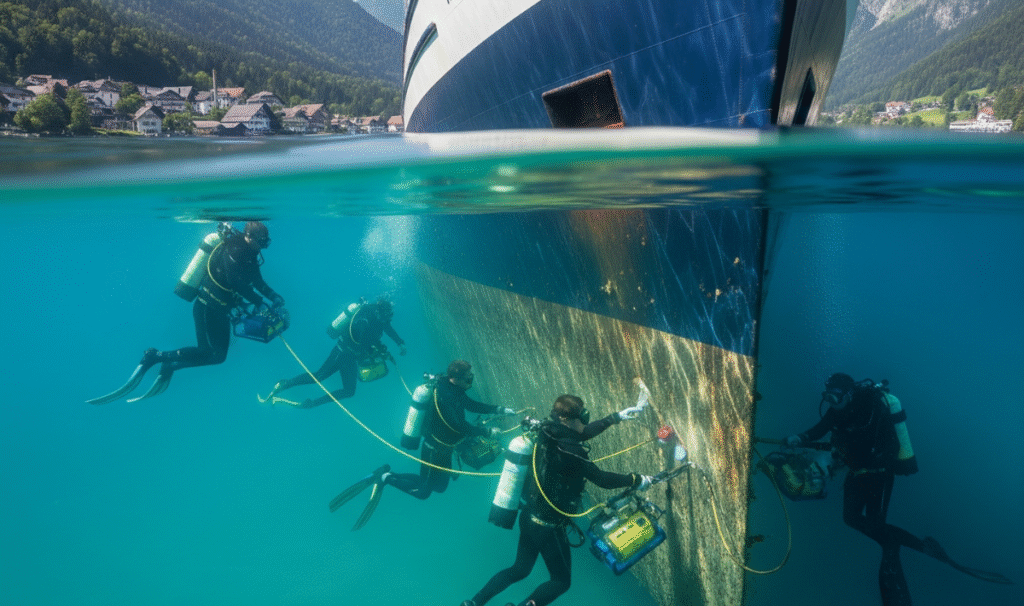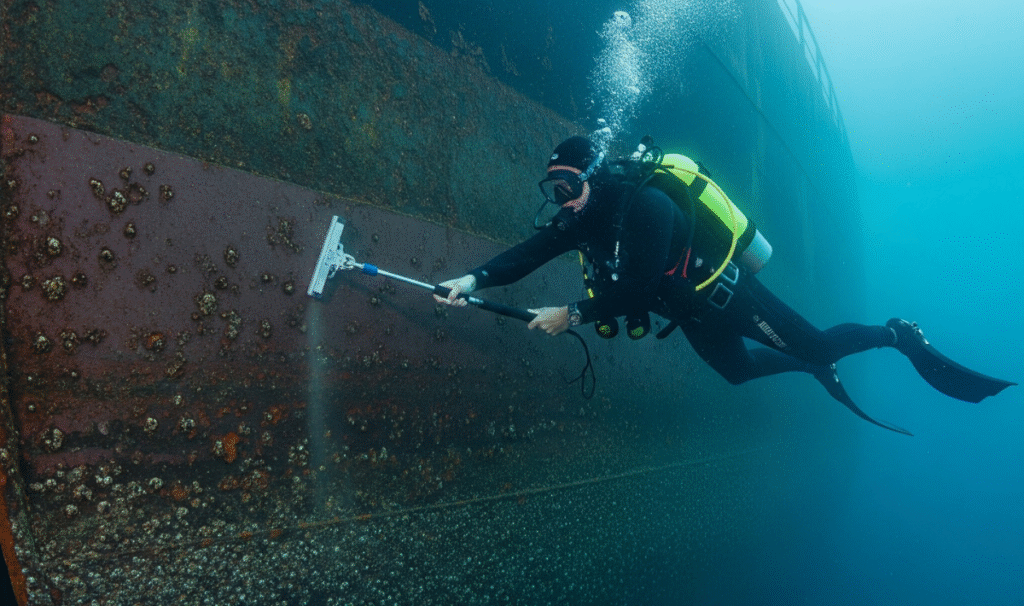If you helm vessels in the bustling port city of Manzanillo, the phrase underwater hull cleaning in Manzanillo is more than just a maintenance task—it’s a critical practice with a daily impact on your operation. Imagine your hull like a runner’s shoe: as soon as it’s caked with mud and barnacles, every step is slower and harder. In the Pacific gateway of Manzanillo, life beneath the waves is always looking for a free ride, and a neglected hull means unnecessary expense, risk, and even legal trouble. Let’s dive into everything you need to know to keep your hull—and your business—running smoothly.
Why is Underwater Hull Cleaning in Manzanillo Vital?
Manzanillo is one of Mexico’s busiest Pacific ports, teeming with container ships, tankers, yachts, and fishing fleets. Every vessel that sits in this warm, biologically rich water is a floating invitation to barnacles, algae, tube worms, and seaweed. When these settle on your hull, they’re not just hitchhikers—they’re costing you speed, burning more fuel, and risking your compliance with both IMO and local port regulations.
The Marine Environment of Manzanillo—Unique Fouling Challenges
Manzanillo’s nutrient-rich waters and active currents make it a hotspot for marine growth. Ships can develop heavy fouling within weeks—especially after idle periods or during warm seasons. Without timely cleaning, hulls may carry dense biological buildup that impacts performance and fuel use.
Compliance with antifouling and cleaning regulations, such as those outlined under MARPOL, is essential to avoid penalties and protect local ecosystems.

What Happens if You Skip Underwater Hull Cleaning in Manzanillo?
Ignoring underwater hull cleaning in Manzanillo is like leaving your car unwashed for months—except far costlier and riskier:
- Skyrocketing fuel use: Fouled hulls experience much more drag, meaning you burn more diesel for every mile covered—sometimes 10–15% more.
- Sluggish speed and maneuverability: Marine growth drags your hull, sapping power and slowing transits.
- Risk to coatings and materials: Barnacles and biofouling damage paint and protective coatings, exposing the hull to corrosion and decay.
- Sensors and intakes compromised: Growth on hull-mounted equipment means unreliable readings and operational issues.
- Regulatory headaches: Port authorities require clean hulls to prevent the spread of invasive species. Ignore this and you risk fines or being denied entry.
The Process of Underwater Hull Cleaning in Manzanillo
CleanShip.co brings professional underwater hull cleaning in Manzanillo with industry-leading expertise, advanced equipment, and a strict focus on environmental and safety compliance.
Dive Safety and Worksite Preparation
Each cleaning starts with a detailed inspection of conditions—currents, weather, vessel position, and potential hazards. Certified dive teams check their gear, coordinate safety patrols, and communicate with port authorities. Manzanillo is a high-traffic zone, so diver and vessel safety always comes first.
Modern Tools, Techniques, and Technology Used
Cleaners use underwater rotary brushes, hydraulic scrapers, and soft pads matched to hull coatings and fouling types. Divers frequently use underwater cameras and ROVs for documentation before, during, and after the job. Many teams deploy debris containment systems to capture removed fouling, ensuring compliance with local regulations and reducing pollution risk.
How to Choose a Service of Underwater Hull Cleaning in Manzanillo
With many providers operating in Manzanillo, choose experience and compliance over convenience.
Experience, Certifications, and Compliance
- Certified divers who adhere to IMO and Mexican environmental rules.
- Experience with large commercial vessels and local hull conditions.
- Track record for safety and reliability.
- Up-to-date insurance and positive customer reviews.
- Clear protocols for debris collection and responsible disposal.
Cleaning Schedules and Best Practices for Local Conditions
Given the rapid fouling in Manzanillo, proactive owners usually clean hulls every 1–3 months. Frequency depends on vessel type, time in port, and type of anti-fouling coating used. Consistent schedules prevent expensive buildup and help catch early hull issues before they escalate.
Environmental Regulations and Marine Stewardship
Manzanillo enforces strict regulations to prevent marine pollution and the spread of invasive species. Only eco-friendly agents are used, and strict debris containment is expected—no scraping and drifting organisms here. Local regulations echo IMO guidance, favoring hull cleaning methods that do not strip paint or create toxic plumes.
What Does Underwater Hull Cleaning in Manzanillo Cost?
Pricing depends on vessel size and fouling severity. In Manzanillo, rates are typically competitive with those in other international ports and may look like this:
- Small to medium-sized vessels: about MXN 190,000 per cleaning job.
- Prices will rise depending on vessel size, fouling levels, and extra tasks (propeller polishing, inspection reports).
- Services for large ships can range between $5,000 and USD 50,000 internationally, based on complexity and tools used.
Going DIY or Hiring the Pros? Pros, Cons, and Pitfalls
While DIY cleaning may seem cost-effective, it carries serious drawbacks:
- Safety risks in a busy, commercial harbor.
- Possible damage to hull coatings using improper tools.
- Violation of port and environmental regulations.
- Lack of debris captures risks fines and waterway pollution.
Certified professionals bring experience, advanced tools, and knowledge of local law—meaning cleaner hulls, safer teams, and no compliance worries.
Key Benefits: Efficiency, Longevity, Compliance—and More
Investing in professional underwater hull cleaning in Manzanillo pays off:
- Fuel savings that can reach up to 10% or more, reducing operational costs.
- Better speed and maneuverability allow for reliable scheduling and on-time arrivals.
- Longer-lasting coatings prevent buildup and corrosion.
- Regulatory peace of mind—you stay compliant and avoid fines.
- Early detection of hull, propeller, or intake problems.

Manzanillo Mariners: Stories from the Port
Local captains and shipping agents routinely share how regular hull cleaning improved fuel efficiency and permitted smoother entry into international ports without incident. One maintenance manager recalled avoiding a major repair bill by spotting corrosion early during a routine underwater hull inspection, all thanks to a scheduled cleaning.
Conclusion: Clean Hulls, Smooth Sailing in Manzanillo
Underwater hull cleaning in Manzanillo is more than service: it’s a safety net, a financial strategy, and a commitment to environmental stewardship. With advanced tools, certified teams, and modern compliance standards, today’s underwater cleaning means your vessel is always ready for the next voyage—swift, efficient, and up to code. The Pacific may try to claim your hull, but with regular care, every journey from Manzanillo flows swift as a dolphin’s leap.
FAQ:
Q1. How often should I schedule underwater hull cleaning in Manzanillo?
For most vessels, this is every 1–3 months, depending on usage, coating type, and fouling rates.
Q2. Are there environmental regulations I need to follow?
Yes, Manzanillo ports require proper debris containment and use of environmentally-friendly cleaning methods.
Q3. What’s the typical cost of professional underwater hull cleaning in Manzanillo?
Q4. Is DIY hull cleaning allowed or recommended?
DIY cleaning in Manzanillo’s commercial waters is risky and discouraged due to safety and regulatory considerations.
Q5. How does cleaning hulls impact my bottom line?
Fuel efficiency improves, maintenance costs drop, hull life extends, and you avoid fines and unplanned downtime.


